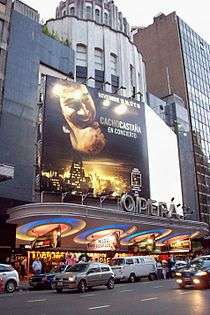Teatro Opera

The Teatro Opera (Opera Theatre) is a prominent cinema and theatre house in Buenos Aires, Argentina.
Overview
The Opera Theatre was developed in 1871 by Antonio Pestalardo under the name of Teatro de la Opera, an Italian businessman who foresaw a need for popular theatre catering to the city's booming population in subsequent years. The original Beaux-Arts style theatre was opened in 1872 on what today is Corrientes Avenue, then a narrow street along Buenos Aires' northern outskirts, and premiered with a performance of Giuseppe Verdi's Il Trovatore. Specializing in operas, the theatre was an early success and enjoyed a reputation of being among the most technically advanced at the time, becoming the first in Latin America to possess in-house generators, for instance.[1]

The massive widening of Corrientes Street led to the theatre's demolition in 1935, however, following which the establishment was sold to Clemente Lococo, who had the Opera Theatre rebuilt. Designed by Belgian Argentine architect Albert Bourdon and reinaugurated in 1936, the new Opera Theatre was an Art Deco, multi-purpose house, hosting both stage performances and film with a capacity for 2,500 spectators. The Corrientes Avenue landmark also hosted regular Tango concerts led by stars including Hugo del Carril and Edmundo Rivero, as well as international performances such as the Folies Bergère's and Ella Fitzgerald's and Louis Armstrong's during their days as a touring duo in the 1950s.[2] The theatre also hosted bandoneonist Ástor Piazzolla's last, live performance in Argentina, in June 1989.[3]
Economic instability and changing public tastes led to the theatre's decline during the 1990s and in 1996, its proprietors considered selling the building to parking structure developers.[4] Public outcry and activism on the part of National Theatre Director Lito Cruz led to the passage of a National Theatre Law providing subsidies to struggling performance houses, as well as protecting them from demolition. The Opera Theatre was remodeled in 1998 and currently seats 1,852 spectators.[2][5]
International performances
Postcards (c. 1910) depicting the original Opera Theatre
References
- Sources
- Mimi Bohm, Buenos Aires Art Deco y Racionalismo, Ediciones Xavier Verstraeten, Buenos Aires, 2008.
- Notes
- ↑ buenosaires.com (Spanish)
- 1 2 Acceder: Cine Teatro Opera (Spanish)
- ↑ piazzolla.org
- ↑ Clarín.18 March 1996.
- ↑ Cinema Treasures
External links
- Official site (Spanish)
Coordinates: 34°36′13.5″S 58°22′44.2″W / 34.603750°S 58.378944°W